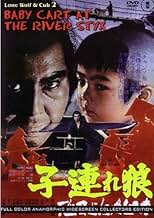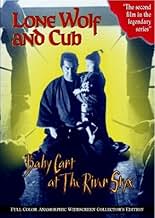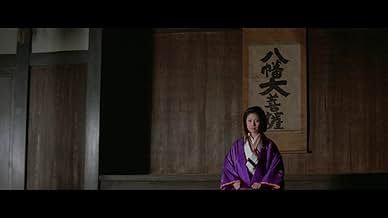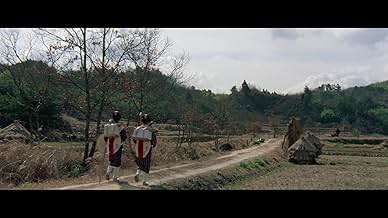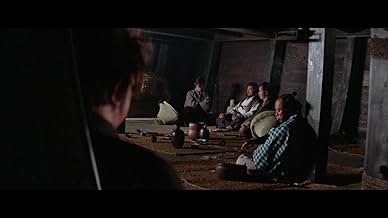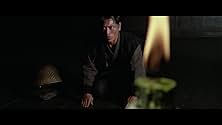Lobo Solitário - O Andarilho do Rio Sanzu
Adicionar um enredo no seu idiomaTrailed by a clan of female ninja, Ogami is paid to assassinate a clan traitor accompanied by three killers known as the Gods of Death.Trailed by a clan of female ninja, Ogami is paid to assassinate a clan traitor accompanied by three killers known as the Gods of Death.Trailed by a clan of female ninja, Ogami is paid to assassinate a clan traitor accompanied by three killers known as the Gods of Death.
- Direção
- Roteiristas
- Artistas
- Mitsugu
- (as Kanji Ebata)
Avaliações em destaque
First few minutes produce a stunning sequence of action mis-en-scene. Baby Cart at the River Styx(1972) is the best of the six film series because of complex character development, interesting story, and outstanding action sequences. The Chimes heard by Ogami Itto and his son, Daigoro during early moments of film are a reminder for them of their painful past. Humorous moment occurs when an owner of a hotel inn takes in Itto and son(Lone Wolf gave him gold pieces to watch over) after thinking of not taking them in moments earlier. There is a brilliant 360 to 180 degree pan of the camera that features an effective tight close up to display expressions of intuition from faces of Ogami Itto and Daigoro.
Places a little more focus into the code and demeanor of Ogami Itto than Part One. Ogami Itto as the Lone Wolf lives by Meifumado as a way towards restoring his family name while at the same time take revenge on the Yagyu clan. Ogami Itto kills without emotion yet a shed of humanity is somewhere within his soul. He is an action character of three dimensional depth that is rare for an action picture. Ogami Itto intriques me as a character of graphic novels and for this instance film because of his strong paternal presence.
Introduces some tough female ninja assassins that Lone Wolf & Cub have to go up against. They seem to be untouchable after dispatching a volunteer of the Kurokuwa group until the female warriors face off with Ogami Itto. Ogami Itto is one tough and determined opponent as the female ninja assassins find out when the majority of this group but one is killed off. The face off between Ogami Itto and Sayaka, the leader of the female assassin group successfully played by Kayo Matsuo has a surreal feel to it. Ogami Itto walking through a path of bodies with a baby cart that has a vegetable stuck in the middle front is a nice comic touch.
The confrontation between Lone Wolf & Cub and the Shogunate's Kurokuwa Ninja group is a combo of artful violent imagery and brilliantly smooth editing. This moment flows smoothly in a way that is hypnotic to the eye and mesmerizing to the brain. Although the scene does have it share of graphic violence, there is never a crude feel in the action as at moments in Sword of Vengeance(1972). Fantastic use of cuts and dissolves to make this moment one of the best action scenes from the first two films. The cinematography used in the action moves with graceful steps.
Lone Wolf and Cub:Baby Cart at the River Styx(1972) really gets at the heart of the story with its complex father/son relationship. The father/son relationship of Itto and Daigoro is what has made the Lone Wolf & Cub stories for so many people. Ogami Itto and Daigoro are tied together by an unbreakable bond that is indescrible in words. The bodily expressions tell more about the relationship of Ogami Itto and Daigoro than any sentence could ever do. An example of this notion happens when the leader of the Kurokuwa Ninja threatens to kill Daigoro is Itto does not give up.
The graphic violence is much higher here than in Sword of Vengenace(1972). The violent battle scenes of BCATRS stir around with stylistic expression. Maybe not as artisticly refined as in samurai films by Akira Kurosawa, but the violent battle scenes at least never feel bland or boring. I can see where filmmakers like John Woo got their influences when I watch the battle scenes of LW&C:BCATRS(1972). The graphic violence in part two and the other films in the series must have played an important influence on the bloody violence in Lucio Fulci's gothic chillers.
Ogami Itto and Daigoro follow a path of blood and corpses that is steeped in tragedy. In living by Meifumado, they are as one who hold a future that is bleak and hopeless. Only when they completely destroy the Yagyu Clan can the Lone Wolf and Cub return to a path of a hopeful future. For Daigoro, dying in the well would have been more merciful than living to an unknown future. Daigoro represents the good, kind side of Ogami Itto whom without would just be cold blooded and ruthless. The tragic path of the two is an element that is fascinating.
The most formidable opponets of Ogami Itto are the Bentenri brothers from part two. The duel between the brothers and the God of Death in the sandy desert is Leonesque. The head splitting moment is the creme de la creme of the duel. Tomisaburo Wakayama for this moment reaches the larger than life heights of Toshiro Mifune. Breathtaking samurai duel with excellent scenery that would have made Sergio Leone proud.
The actors who play the Masters of Death give their characters an unique quirk to make the Bentenrai brothers fascinating villains. One of the actresses(Michie Azuma) who plays a female ninja assassin would have a more substanical role as topless female assassin in Lone Wolf & Cub:Baby Cart in Peril(1972). Part One and Part two of LW&C use identical imagery. Better directed than the first film with fewer slow moments. Lone Wolf & Cub:Baby Cart at the River Styx(1972) stays true emotionally to the graphic novel that the film is based on.
When the wealthy Awa clan approach Itto, offering him 500 gold pieces to kill a man who might be able to ruin them financially, he accepts; in order to complete his mission, he must face many dangers, including a team of vicious female warriors, and the highly skilled Hidari brothers, also known as the Gods of Death.
Baby Cart at the River Styx sees director Kenji Misumi delivering a breathtaking sequel to his excellent Sword of Vengeance. Like a Japanese Sergio Leone, he once again uses extreme close-ups, rapid zooms, sparing use of a haunting soundtrack, and superbly choreographed violence to continue his epic tale of a man and boy on a gore-spattered journey through 'hell'.
From the opening scene in which Itto quickly dispatches of two Yagyu clansmen, through to the stunning climax which sees Lone Wolf and Cub battling the Hidaris in a desert, this film is a stunning and often beautiful display of carnage. Battles take place in complete silence, with the vanquished always taking a second or two before they fall to the ground, blood gushing from their wounds. Daigoro also gets in on the act, activating spring-loaded blades in his cart to slice off the feet of the enemy. Misumi's handling of these scenes is superb, with some great use of innovative and ground-breaking visual techniques (one great fight scene has images superimposed onto each other to give the action a surreal and dreamlike quality).
But it's not all mindless violence. There are occasional moments of tenderness too, with the close bond between father and son displayed in a couple of notable scenes: Ogami gently bathes Daigoro, with one hand on his sword in readiness for trouble; and Daigoro nurses his injured father back to health, trading his jacket for food.
My only gripe with Baby Cart at the River Styx is that the film is often very dark, and it was extremely hard to see what was going on, particularly during the many night scenes. Whilst this may be due to my DVD being a bad transfer, it did affect my enjoyment of the film (I had to re-watch the gory dismemberment of one unfortunate shinobi at the hands of the female ninjas with my TV's brightness and contrast whacked right up), which is why I give it slightly less than Sword of Vengeance7.5/10 (although I have to round my rating up to 8 for IMDb, which technically puts it on a par with the first one).
There were a couple of funny moments relating to the little boy and his participation in the various battles. The use of the boy for some humor was a plus.
The fighting scenes were mostly good, but not as good as the Zatoichi movies which I love and have seen them all. The bloody effects were pretty bad in some scenes, as the injured (killed) samurai sometimes started bleeding many seconds after they were stabbed or sliced. In one scene, Lone Wolf impales two guys at the same time. One of them immediately starts spraying lots of blood from his wound. The other guy gets a trickle of blood dripping out. It would have been more impressive if the double-impalement lead to double sprays of blood.
Several heads were sliced open, and the last one looked like a venus flytrap popping open, and there were no brains, eyes, or other material visible, it looked totally silly. Then a single spray of blood shot straight up into the air from the middle of the head. Laughable and really bad special effects.
Otherwise, the film was pretty good. It had a lot of action, some good story lines, and some humor.
Forget Toshiro Mifune. Forget Takakura Ken. Forget Sonny Chiba. Forget Bruce Lee, Jackie Chan, Jet Li, Donnie Yen, and any of those wire-reliant ballet dancers from Crouching Tiger Hidden Dragon. And CERTAINLY forget any American martial artists that you could care to name. Tomisaburo Wakayama was, is, and forever shall be, THE MAN!
Você sabia?
- CuriosidadesThe distinctive hats worn by the Gods of Death, are a traditional Japanese straw hat often associated with ronin. The style of hat is known as roningasa. 'Ronin' meaning masterless and wandering samurai, and 'gasa' meaning hat.
- Erros de gravaçãoWhen Ogami and Daigoro are walking through the forest shortly before being attacked by Kurokawa and his ninja henchmen (around the 31:30 mark), cars can be seen driving by in the background on the left side of the frame.
- Citações
Benma Hidari: [Ogami Itto has bested him and slashed him across the neck with a sword; blood is starting to flow from the wound, making a certain sound] My neck... my own neck... It sounds like it's wailing. My neck was sliced open diagonally. The cut wails like a cold winter wind. They call it "mogari-bue," - the whistle of a fallen tiger. I've always wished to kill someone, just once, and create such a fine cut and to sing this tune. Now I'm hearing it from my own neck. What a laugh.
[rolls over dead, with blood spurting out from his neck wound onto the sand]
- ConexõesEdited into Ninja Assassino (1980)
Principais escolhas
- How long is Lone Wolf and Cub: Baby Cart at the River Styx?Fornecido pela Alexa
Detalhes
- Data de lançamento
- País de origem
- Idioma
- Também conhecido como
- Lone Wolf and Cub: Baby Cart at the River Styx
- Empresas de produção
- Consulte mais créditos da empresa na IMDbPro
Contribua para esta página


